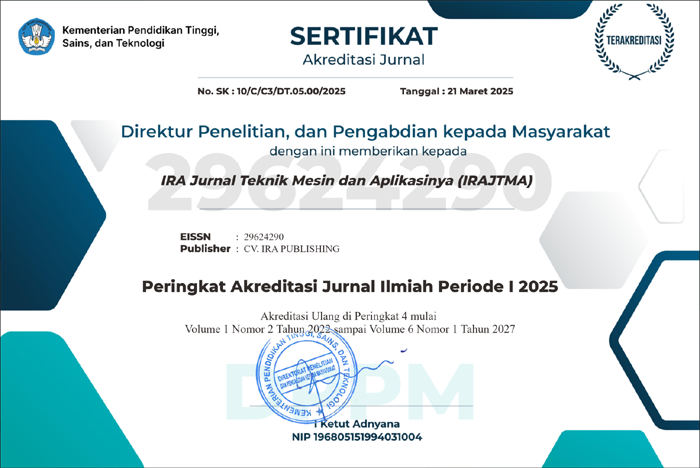Waste Heat Potential Test from One and Two Furnace Gas Stoves Discharged into the Environment
DOI:
https://doi.org/10.56862/irajtma.v1i2.20Keywords:
Environment, LPG gas stove, recovery heat, waste heatAbstract
This research aims to measure the temperature around the burner of a single and two-burner SNI gas stove experimentally. The method involves installing temperature sensors at various points around the burner to measure the temperature distribution during stove operation. Testing one stove with the maximum gas stove setting shows that the temperature of the flame (Tf), inner wall (Ti), and outer wall (To) has an average value of 515.7426°C, 159.4874°C, and 123 respectively. .9852°C. With the minimum gas stove setting, the average values of Tf, Ti, and To are 412.9672°C, 101.7448°C, and 64.1360°C. For testing two stoves with the maximum gas stove setting, the average values of Tf, Ti, and To were 666.9459°C, 146.0443°C, and 81.8967°C respectively, while for the minimum gas stove setting, The average values of Tf, Ti, and To are 596.623°C, 94.6196°C, and 60.9590°C. The results of this measurement indicate that the heat lost to the environment through radiation is still significant, as can be seen from the high temperatures measured on the inner and outer walls of the plate around the burner. These findings are important for improving the design of gas stoves to increase energy efficiency and reduce heat lost to the environment.
References
Atmoko, Nugroho Tri, Ibham Veza, T Widodo, and B Riyadi. 2021. “Study on the Energy Conversion in the Thermoelectric Liquefied Petroleum Gas Cooking Stove with Different Cooling Methods.” Vol 69:185–93.
Chang, Chih-Chung, Jiunn-Guang Lo, and Jia-Lin Wang. 2001. “Assessment of Reducing Ozone Forming Potential for Vehicles Using Liquefied Petroleum Gas as an Alternative Fuel.” Atmospheric Environment 35 (35): 6201–11. https://doi.org/https://doi.org/10.1016/S1352-2310(01)00386-7.
Das, Mithun, Ranjan Ganguly, Amitava Datta, Meenam M Verma, and Ashis K Bera. 2021. “Performance Improvement of a Domestic Liquefied Petroleum Gas Cook Stove Using an Extended Spill-Tray and an Annular Metal Insert.” Journal of Thermal Science and Engineering Applications 13 (2): 21016.
Dekoruma, Kania. 2018. “7 Jenis Kompor Gas, Yang Mana Yang Kamu Butuhkan?” Dekoruma. 2018. https://www.dekoruma.com/artikel/74975/jenis-kompor-gas#kania.
Kshirsagar, Abhimanyu Anil, and Kiran P. Pawar. 2018. “Waste Heat Recovery from Porous LPG Gas Burner Used for Cooking.” International Research Journal of Engineering and Technology (IRJET) 5 (5): 3192–95. https://www.irjet.net/archives/V7/i3/IRJET-V7I3514.pdf.
Ravindran, Narayana Vijesh, and ArulmozhiVarman Seetharaman. 2014. “Waste Heat Recovery From Porous LPG Gas Burner Used For Cooking.” In International Mechanical Engineering Congress and Exposition, 1–8. Quebec, Canada: ASME. https://doi.org/https://doi.org/10.1115/IMECE2014-36115.
Shipman, R H. 2002. “14 - Liquefied Petroleum Gas.” In , edited by Dennis A B T - Plant Engineer’s Reference Book (Second Edition) Snow, 14. Oxford: Butterworth-Heinemann. https://doi.org/https://doi.org/10.1016/B978-075064452-5/50069-9.
Thoday, Katharine, Precious Benjamin, Meixi Gan, and Elisa Puzzolo. 2018. “The Mega Conversion Program from Kerosene to LPG in Indonesia: Lessons Learned and Recommendations for Future Clean Cooking Energy Expansion.” Energy for Sustainable Development 46:71–81. https://doi.org/10.1016/j.esd.2018.05.011.
Downloads
Published
How to Cite
Issue
Section
License
Copyright (c) 2024 IRA Jurnal Teknik Mesin dan Aplikasinya (IRAJTMA)

This work is licensed under a Creative Commons Attribution-ShareAlike 4.0 International License.

















